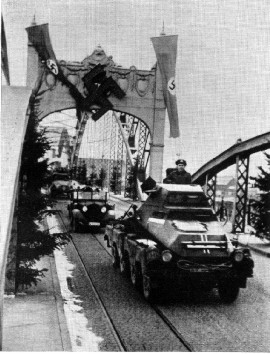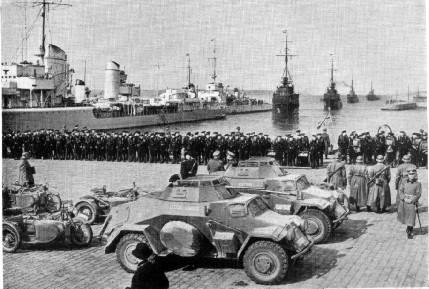..
<B><BIG><BIG>Divisions-Aufklärungs-Abteilung 1</BIG></BIG></B>
<B><BIG><BIG></BIG></BIG></B>
Aufgestellt am 18. August 1939 in Allenstein aus der 1. (Reit.) und 6. (Radf.) Schwadron des Kavallerie-Regiments 4 und der 1. Infanterie-Division unterstellt. Am 15. Oktober 1942 in die Radfahr-Abteilung 1 umbenannt. Am 21. April 1943 erfolgte die Rückbenennung in
Aufklärungs-Abteilung 1. Am 2. Oktober 1943 erfolgte die Umbenennung in Divisions-Füssilier-Bataillon 1. Ersatztruppenteil war die Kavallerie-Ersatz-Abteilung 1.

Aufklärungs-Abteilung 1 in Tilsit 1939

Aufklärungsabteilung 1 in Königsberg 1939. Die Abteilung wartete auf die Ankunft von Adolf Hitler.
Link: http://www.lexikon-der-wehrmacht.de/Gliederungen/Divisionseinheiten/IDEinheiten1.htm#Divisions-Aufklärungs-Abteilung%201
<B><BIG><BIG>Divisions-Aufklärungs-Abteilung 1</BIG></BIG></B>
<B><BIG><BIG></BIG></BIG></B>
Aufgestellt am 18. August 1939 in Allenstein aus der 1. (Reit.) und 6. (Radf.) Schwadron des Kavallerie-Regiments 4 und der 1. Infanterie-Division unterstellt. Am 15. Oktober 1942 in die Radfahr-Abteilung 1 umbenannt. Am 21. April 1943 erfolgte die Rückbenennung in
Aufklärungs-Abteilung 1. Am 2. Oktober 1943 erfolgte die Umbenennung in Divisions-Füssilier-Bataillon 1. Ersatztruppenteil war die Kavallerie-Ersatz-Abteilung 1.

Aufklärungs-Abteilung 1 in Tilsit 1939

Aufklärungsabteilung 1 in Königsberg 1939. Die Abteilung wartete auf die Ankunft von Adolf Hitler.
Link: http://www.lexikon-der-wehrmacht.de/Gliederungen/Divisionseinheiten/IDEinheiten1.htm#Divisions-Aufklärungs-Abteilung%201






Comment